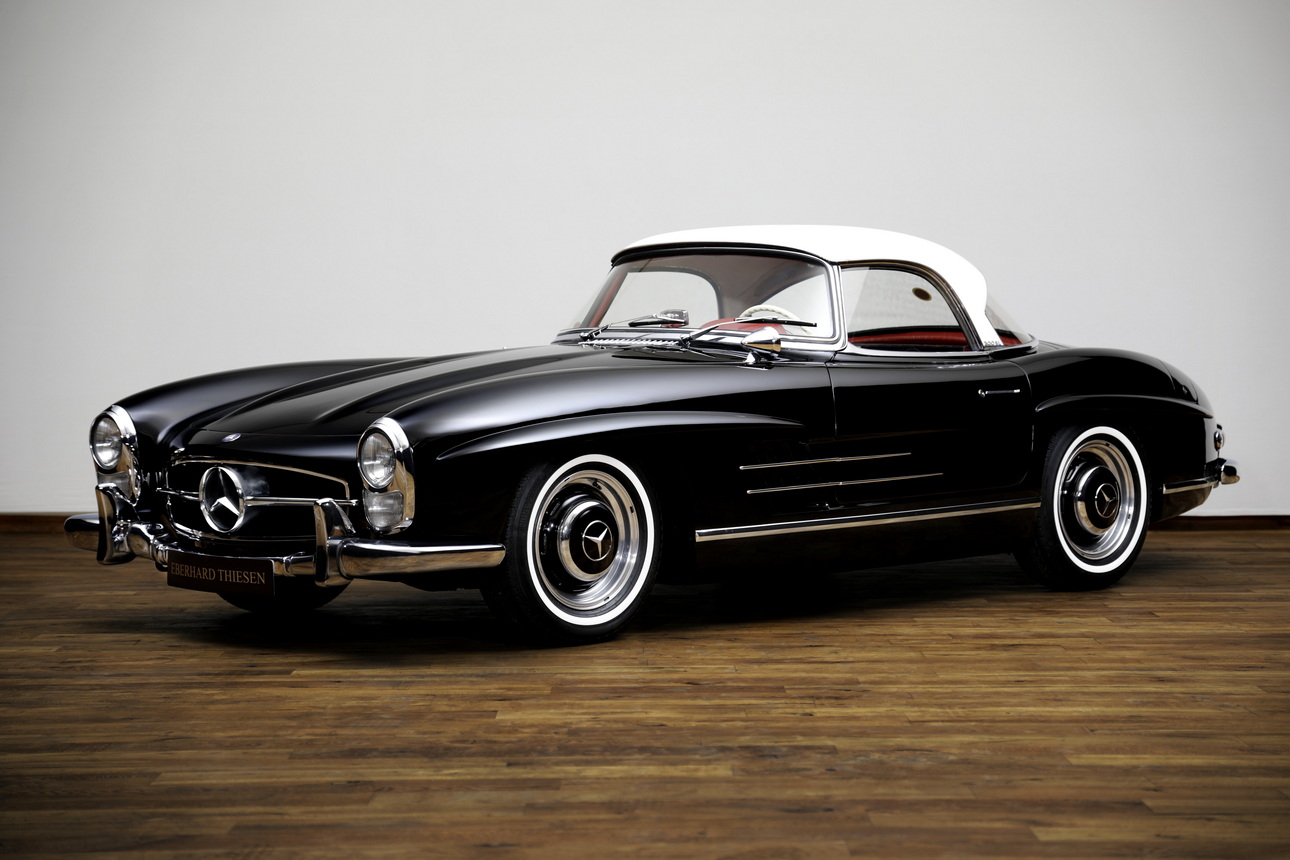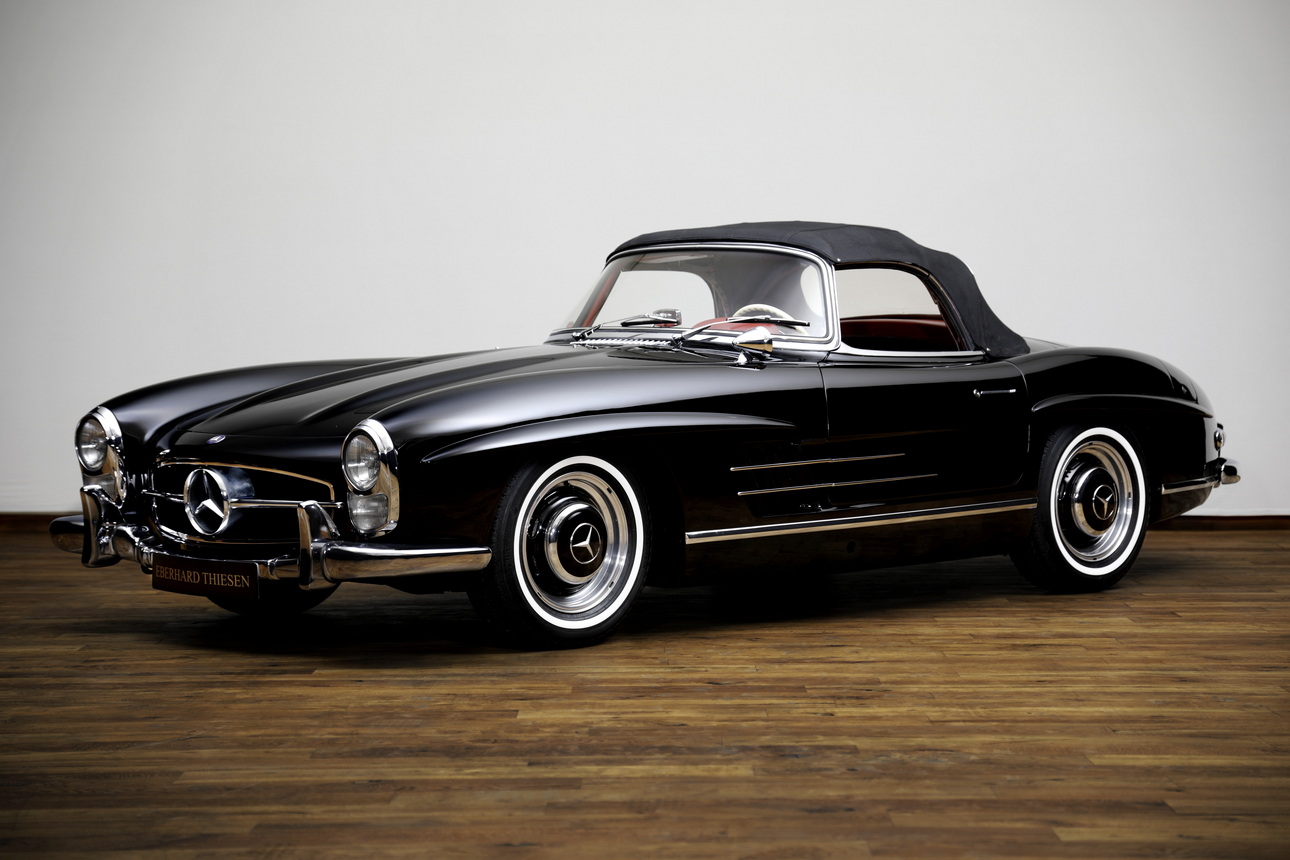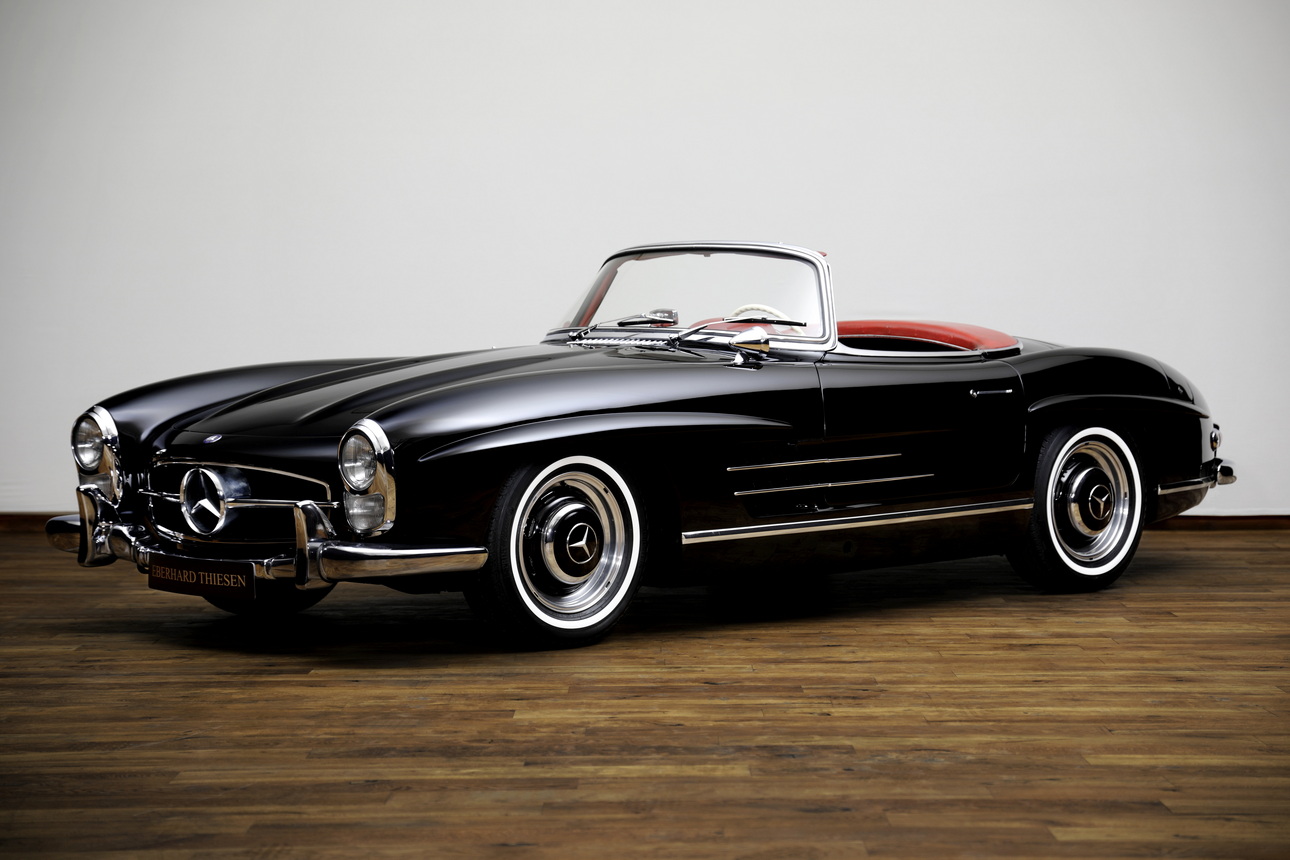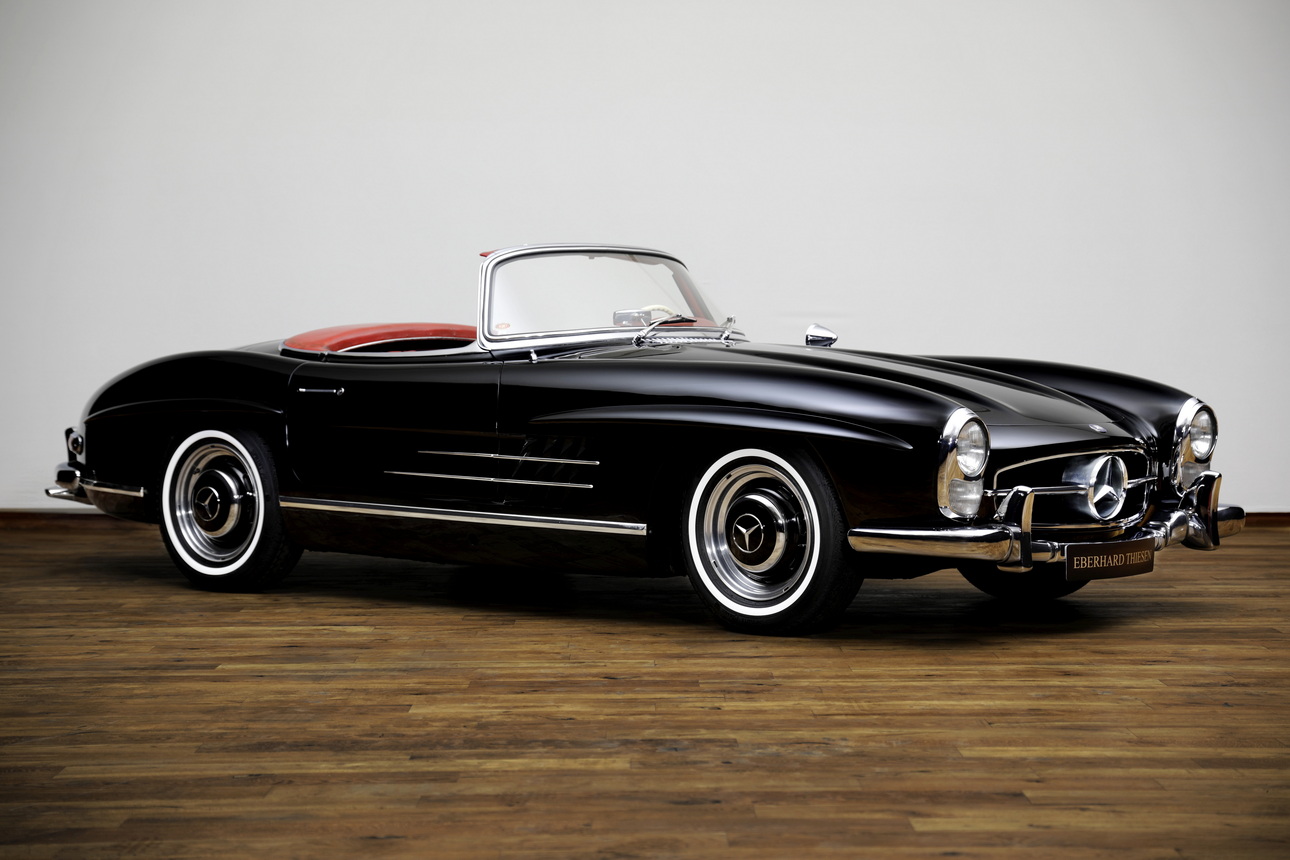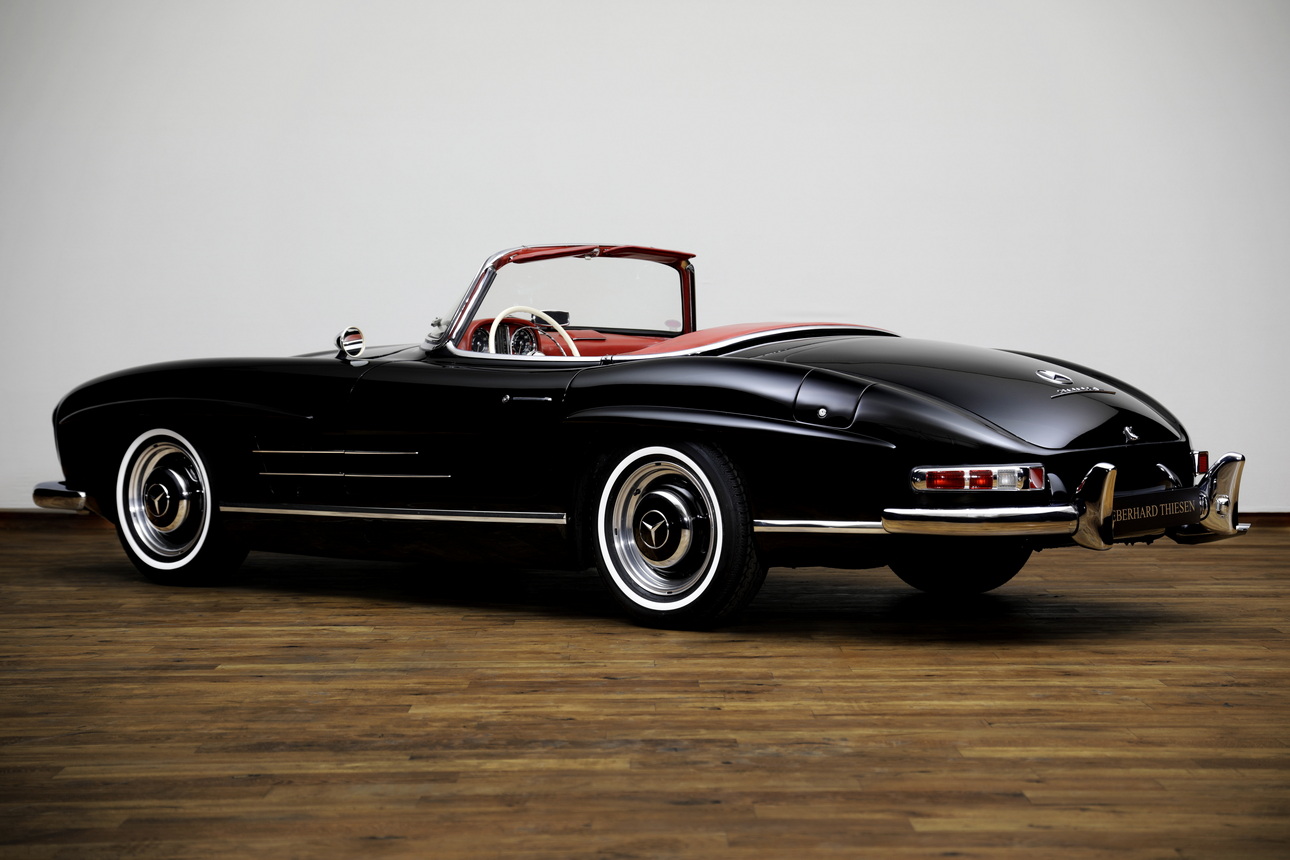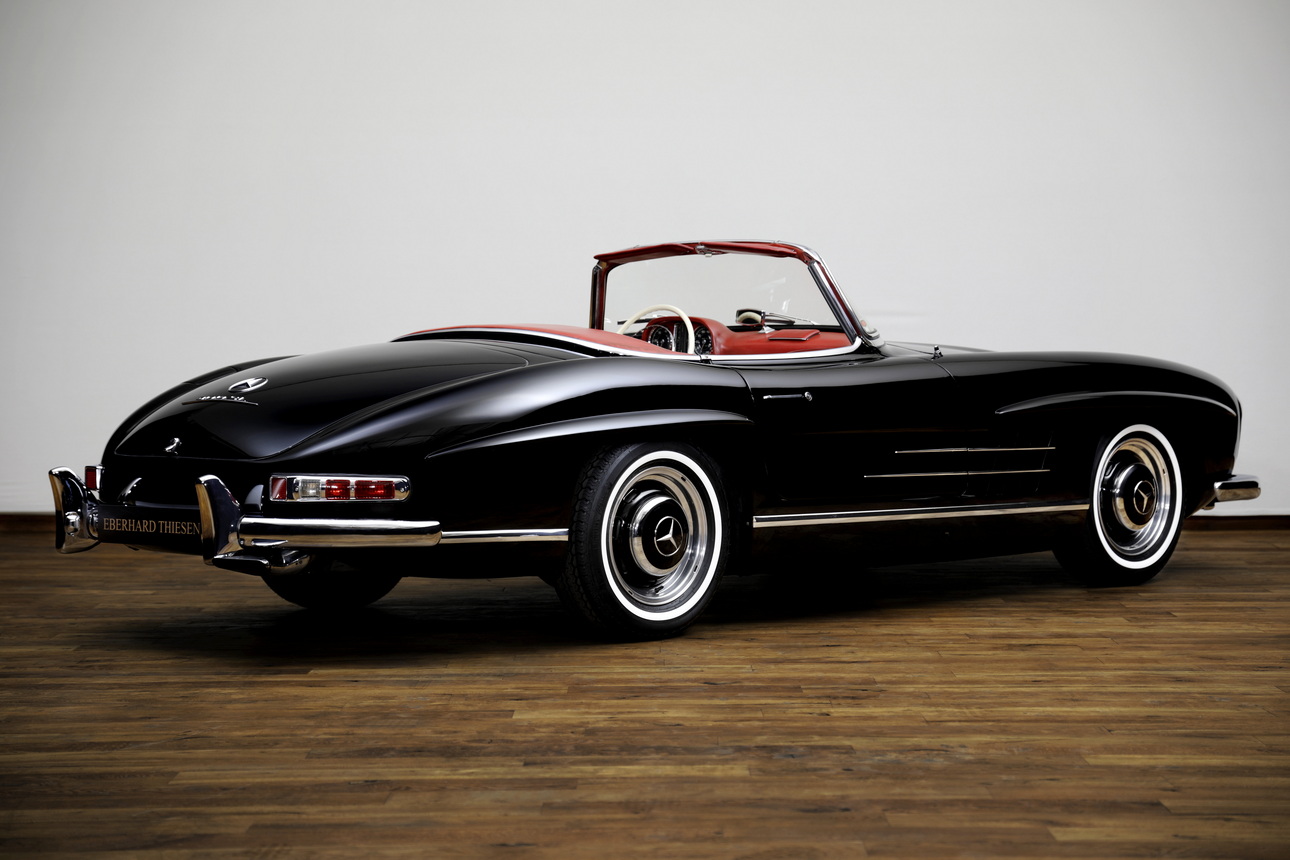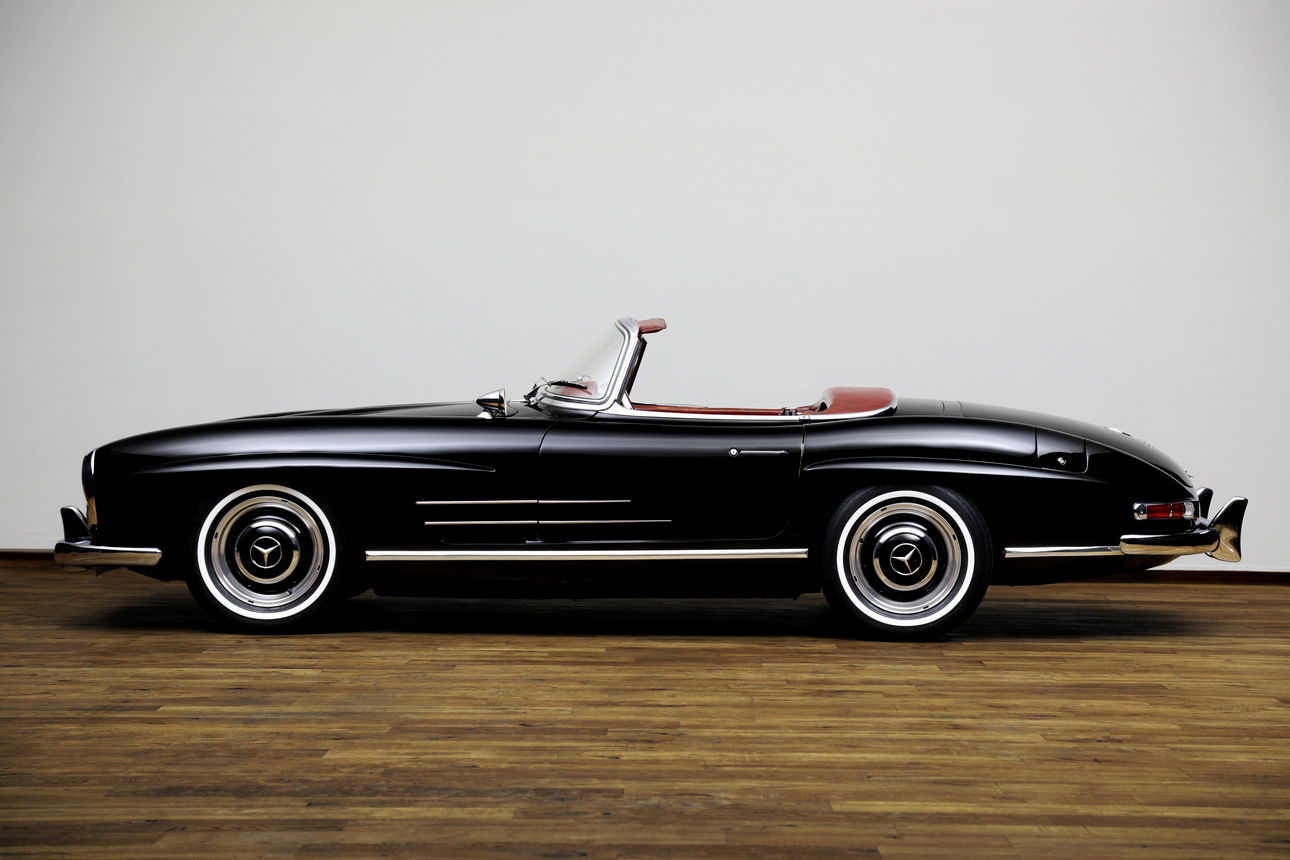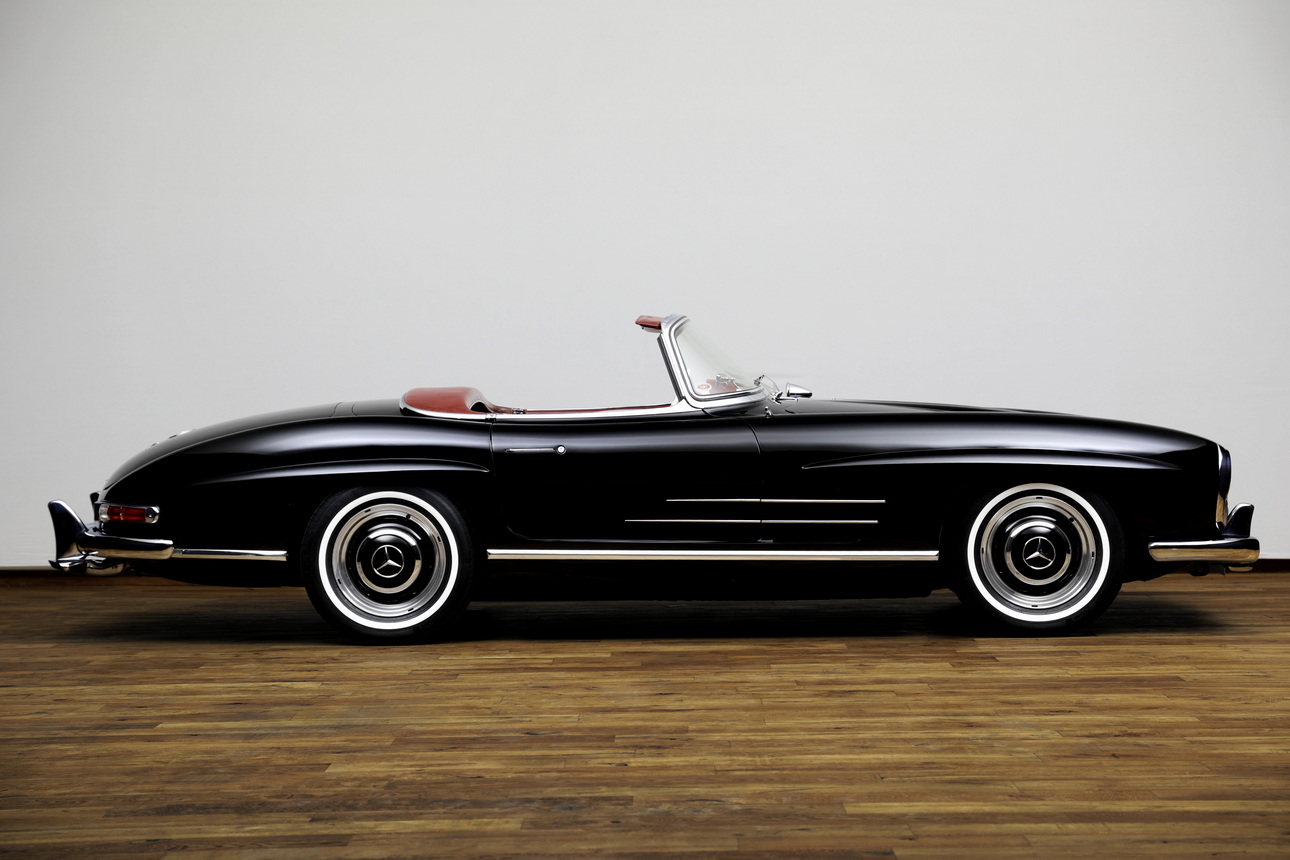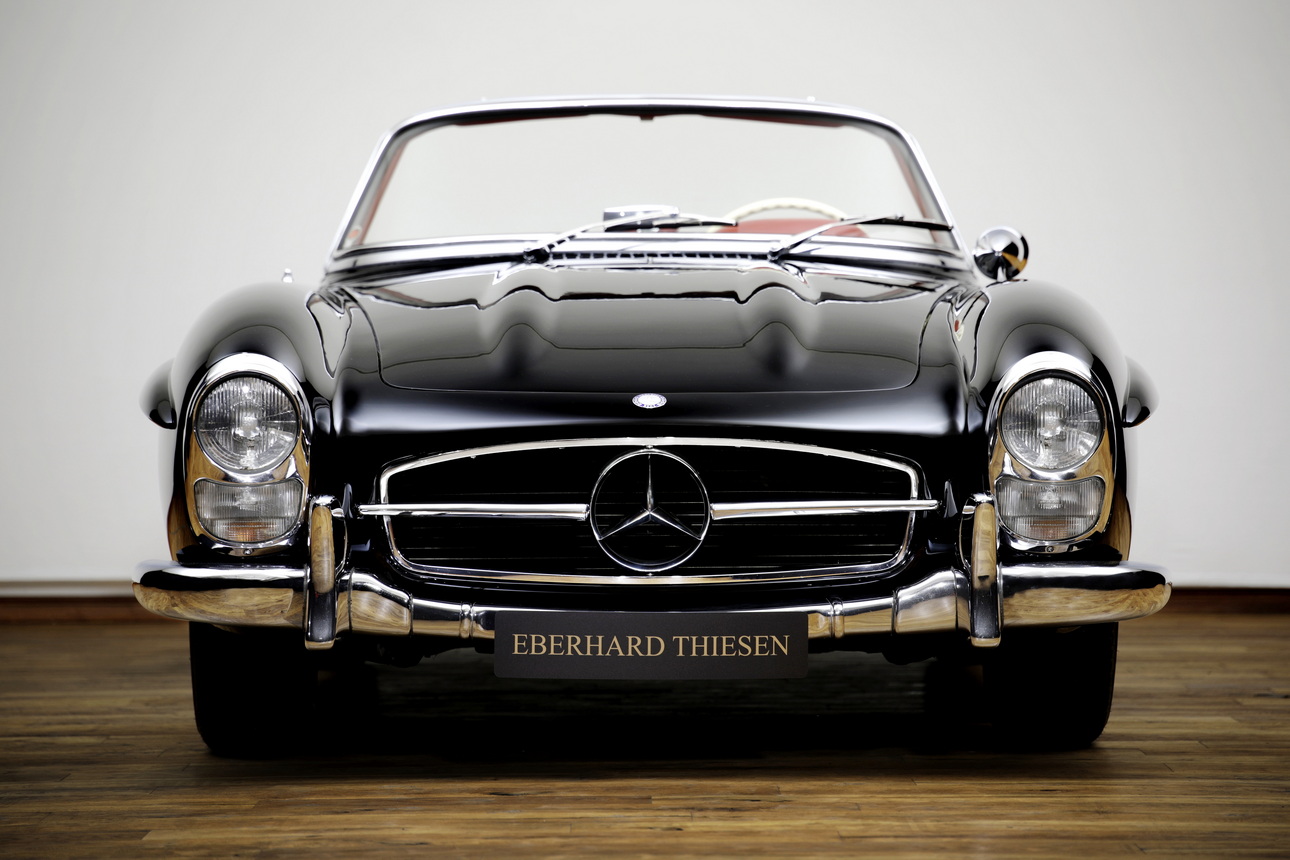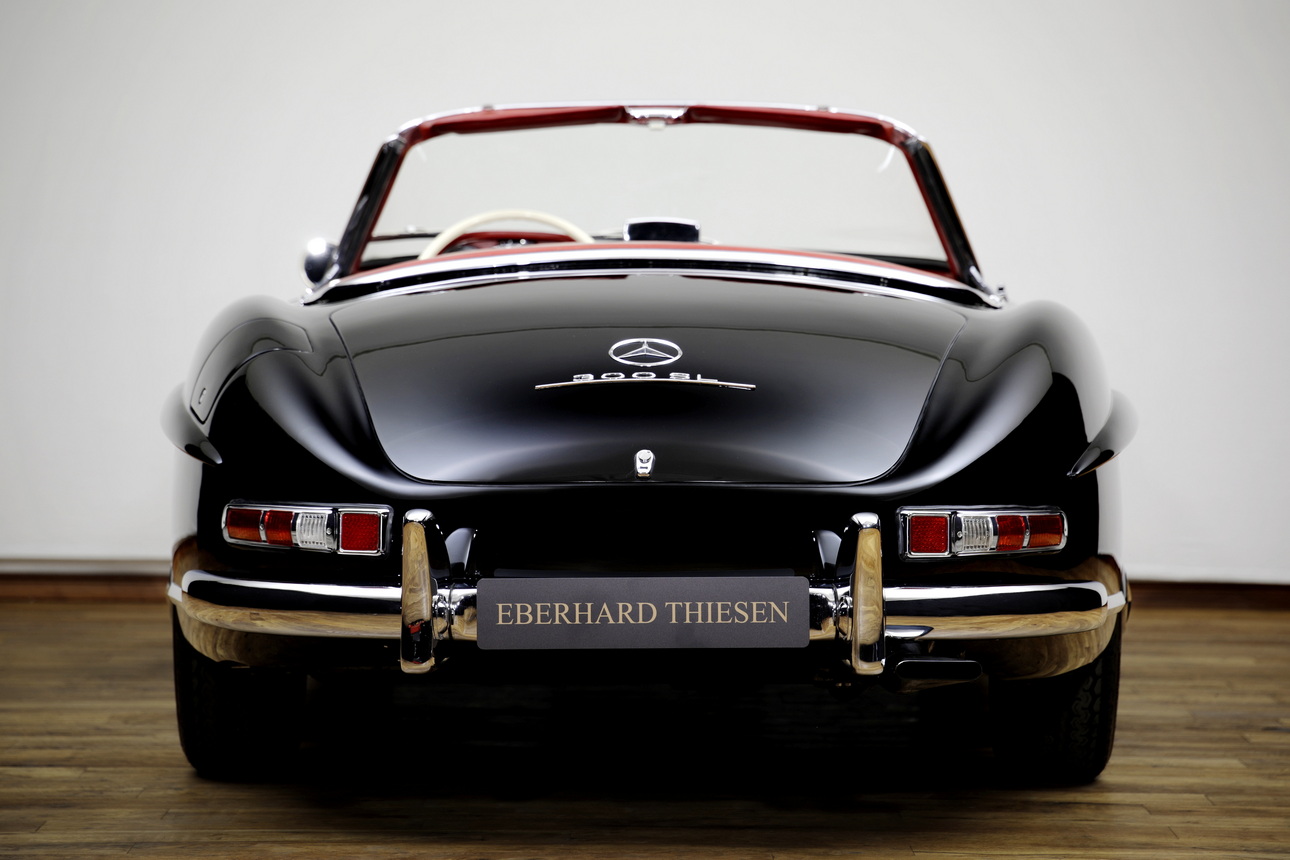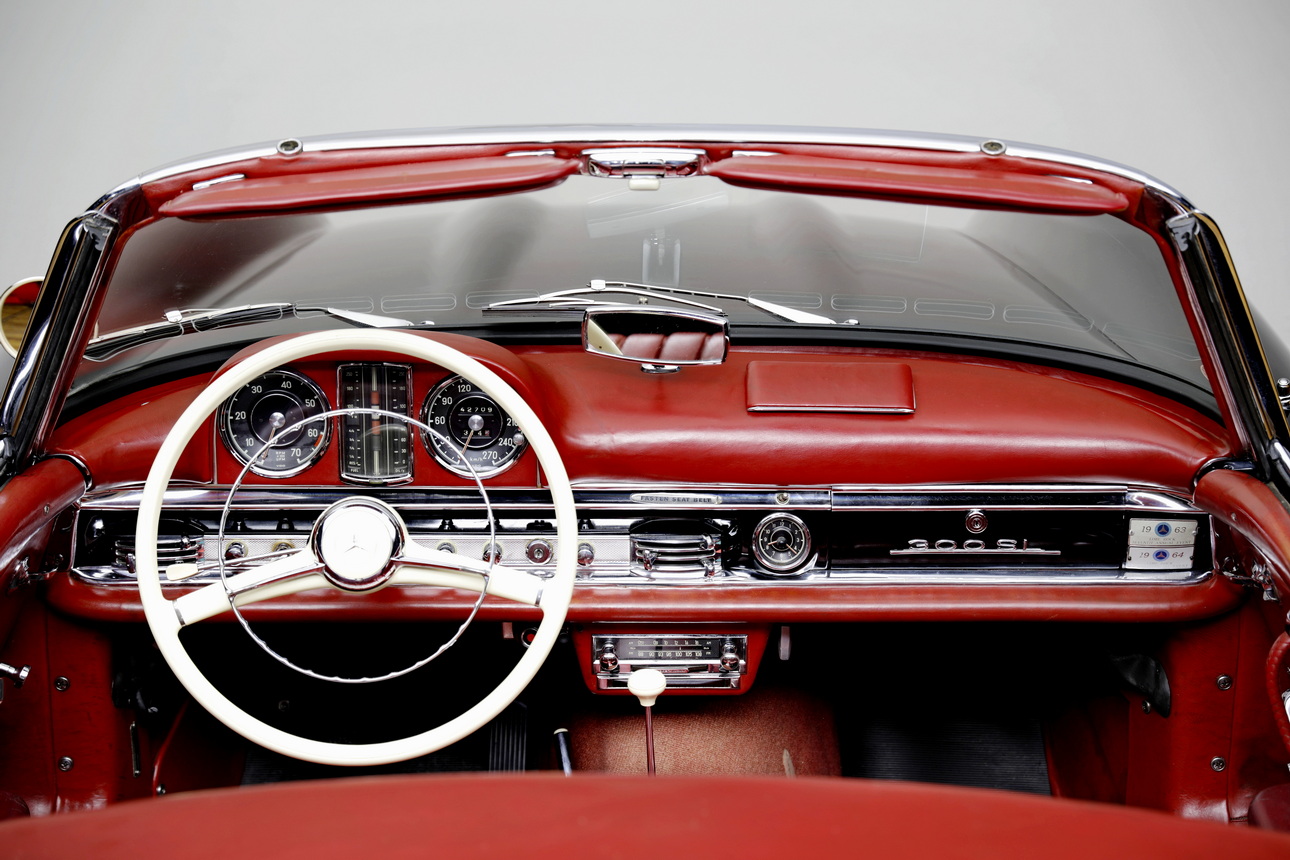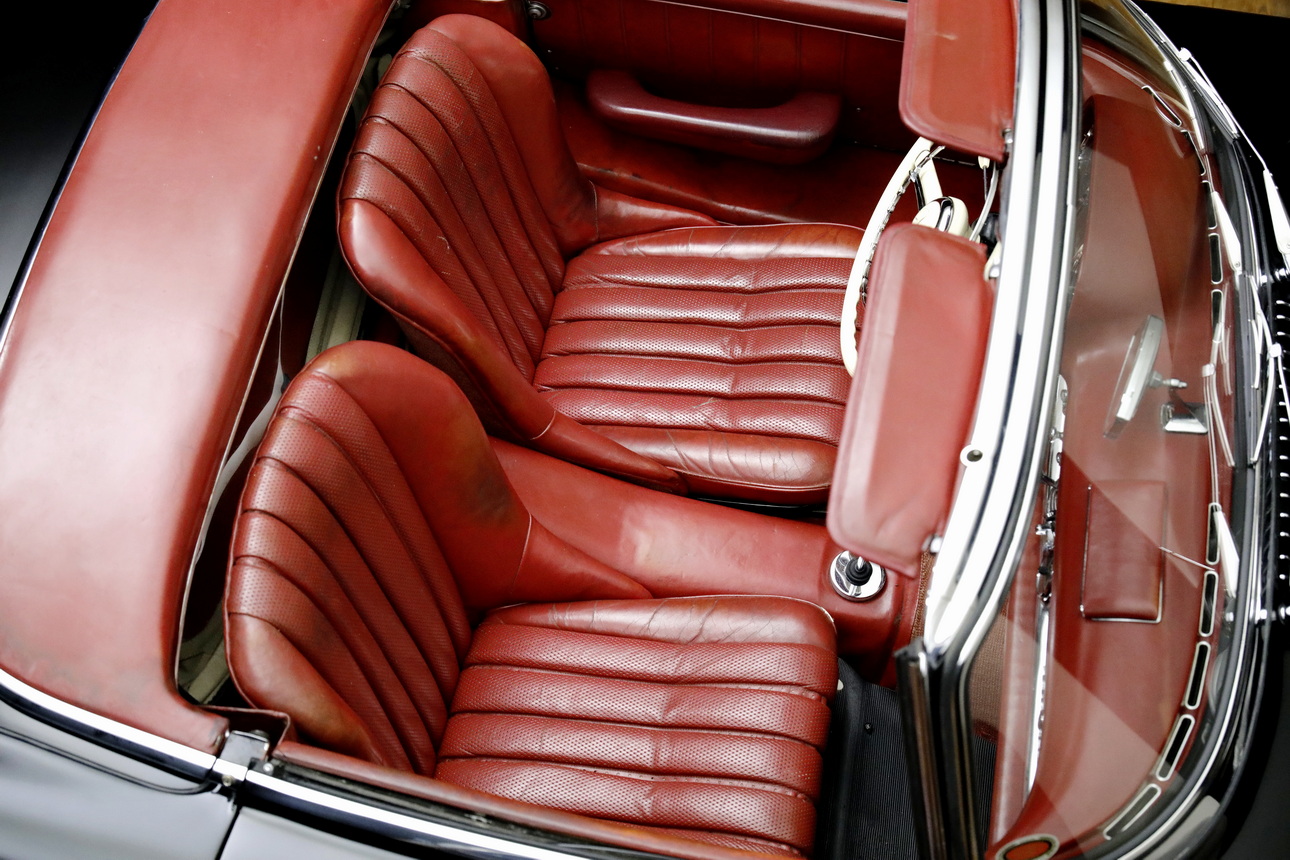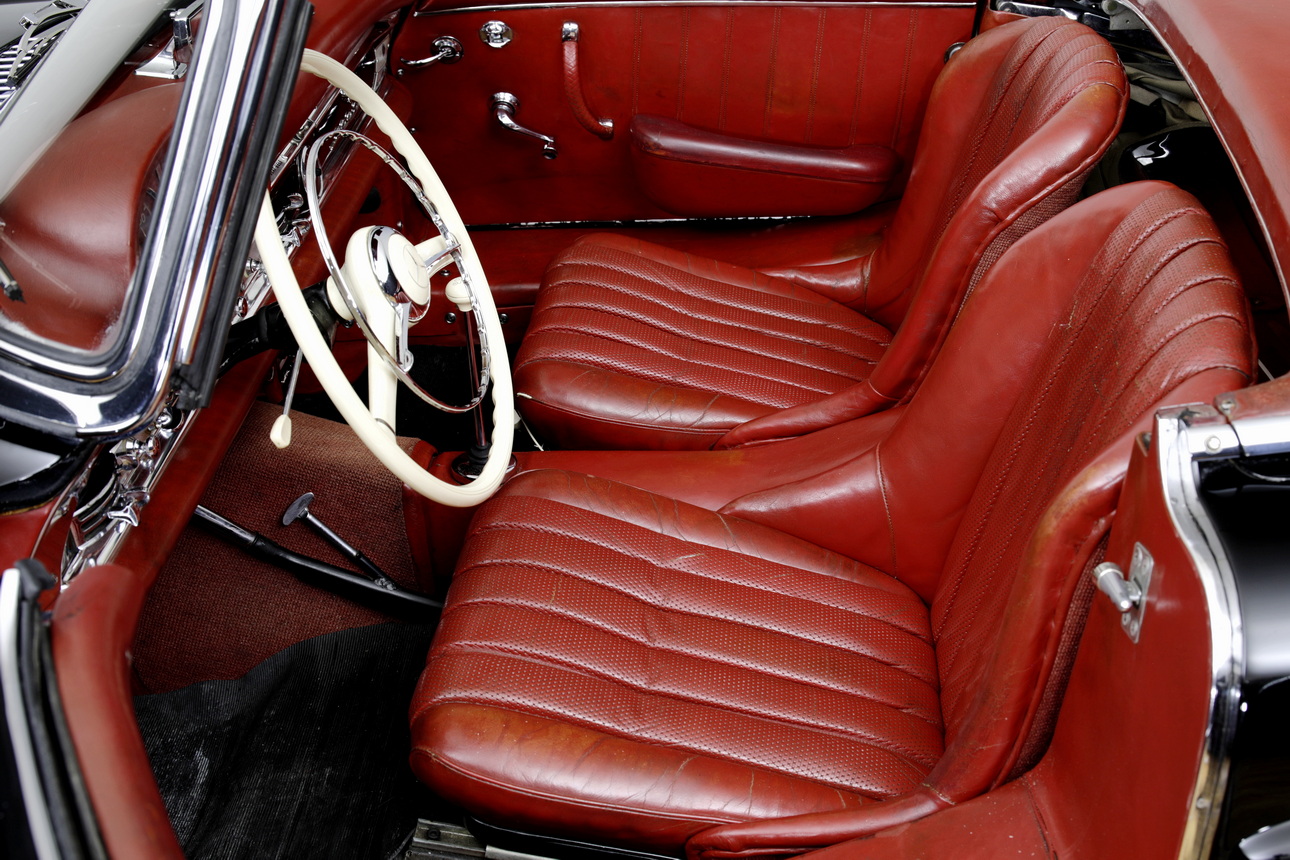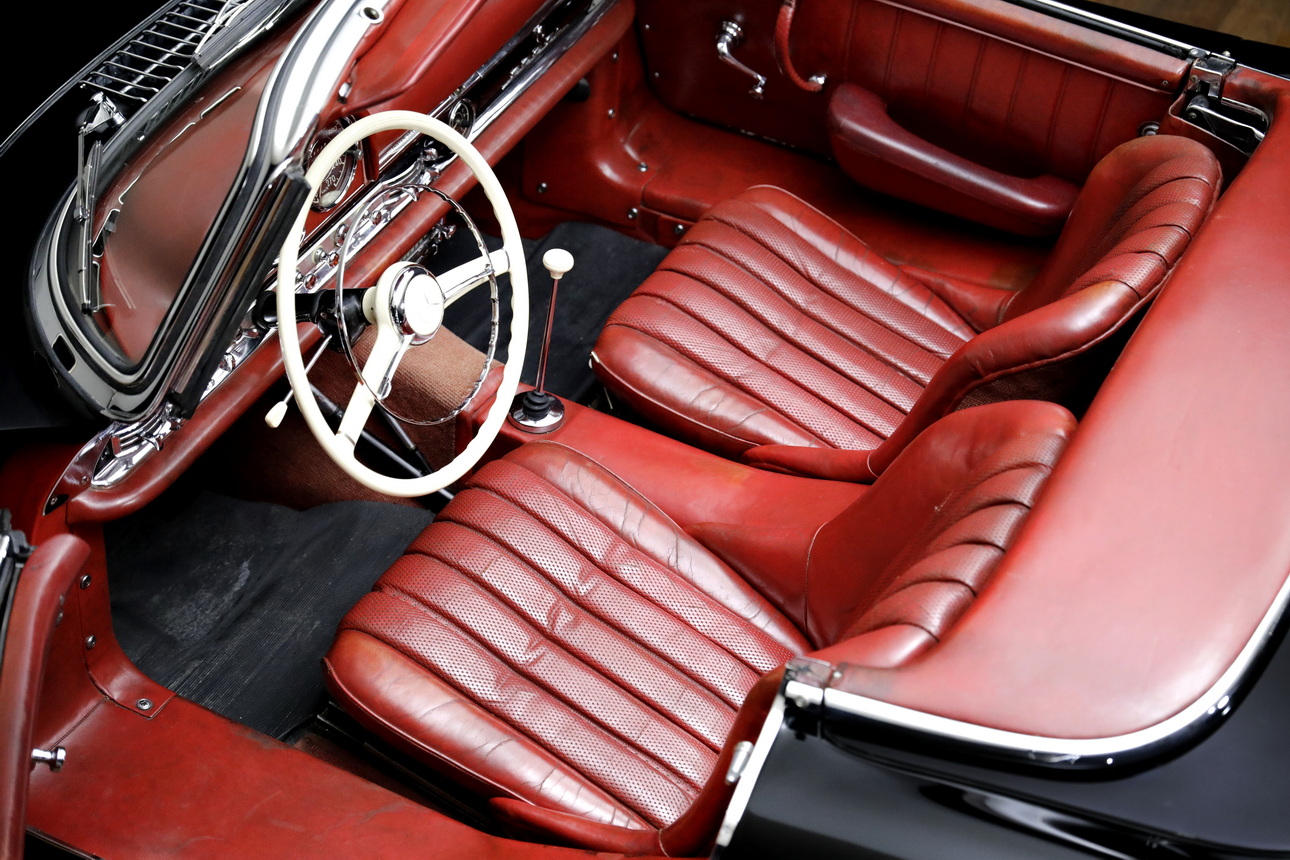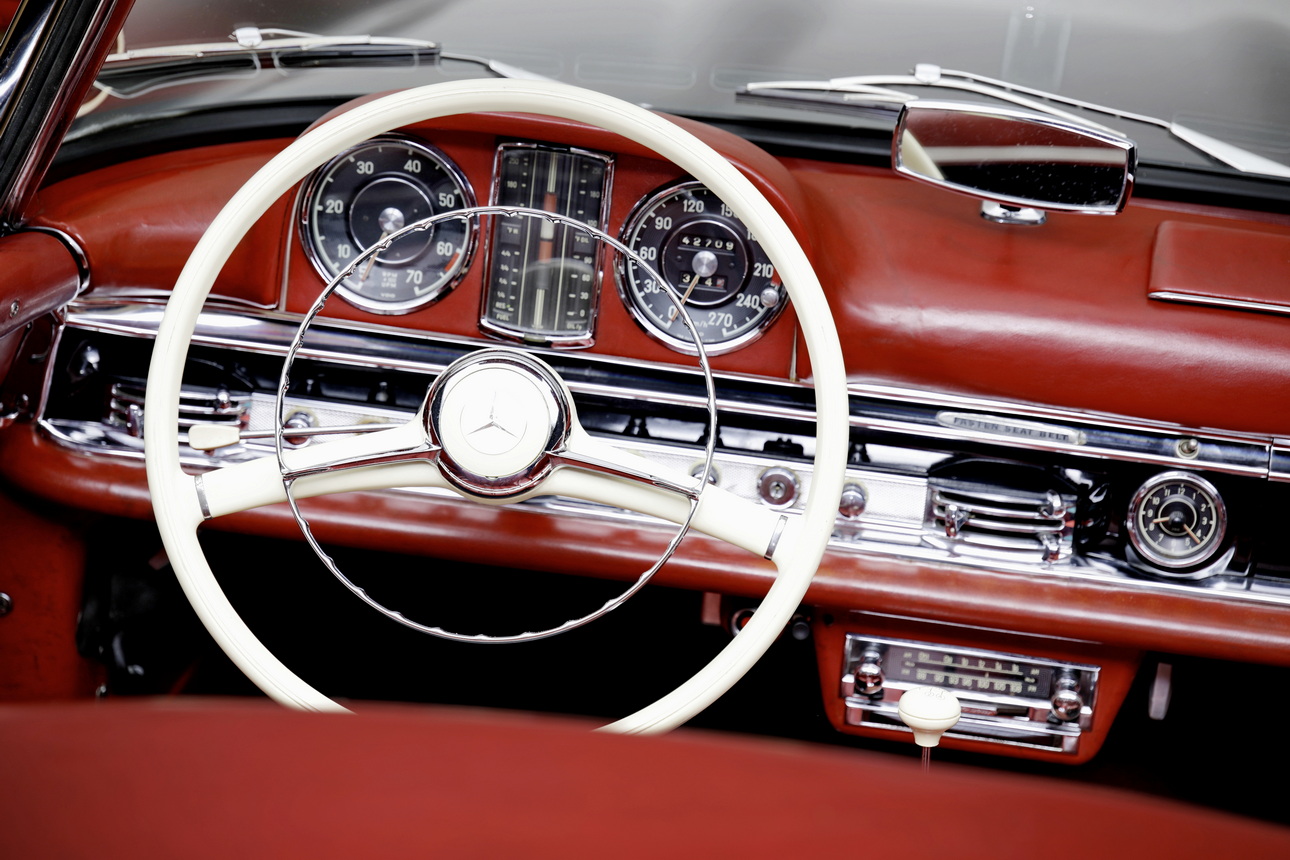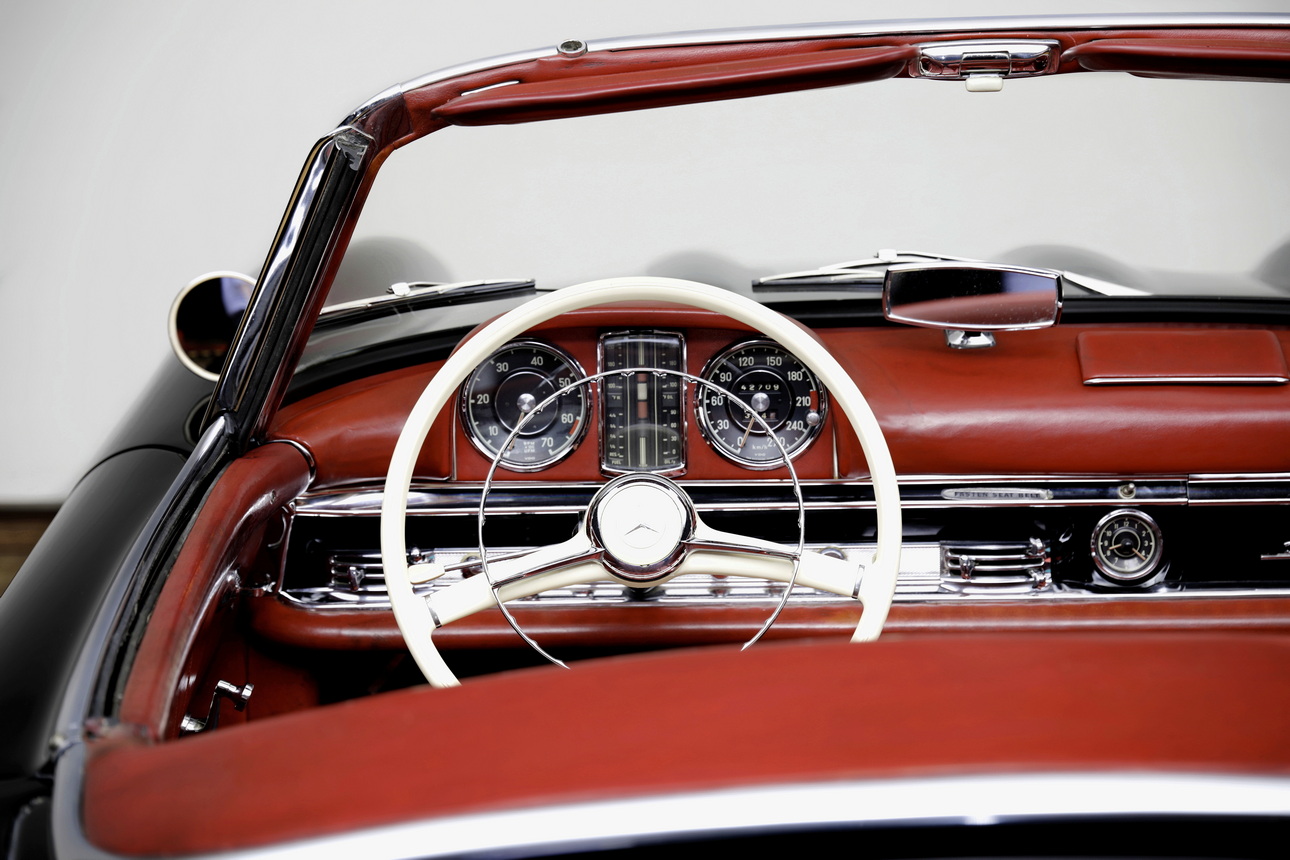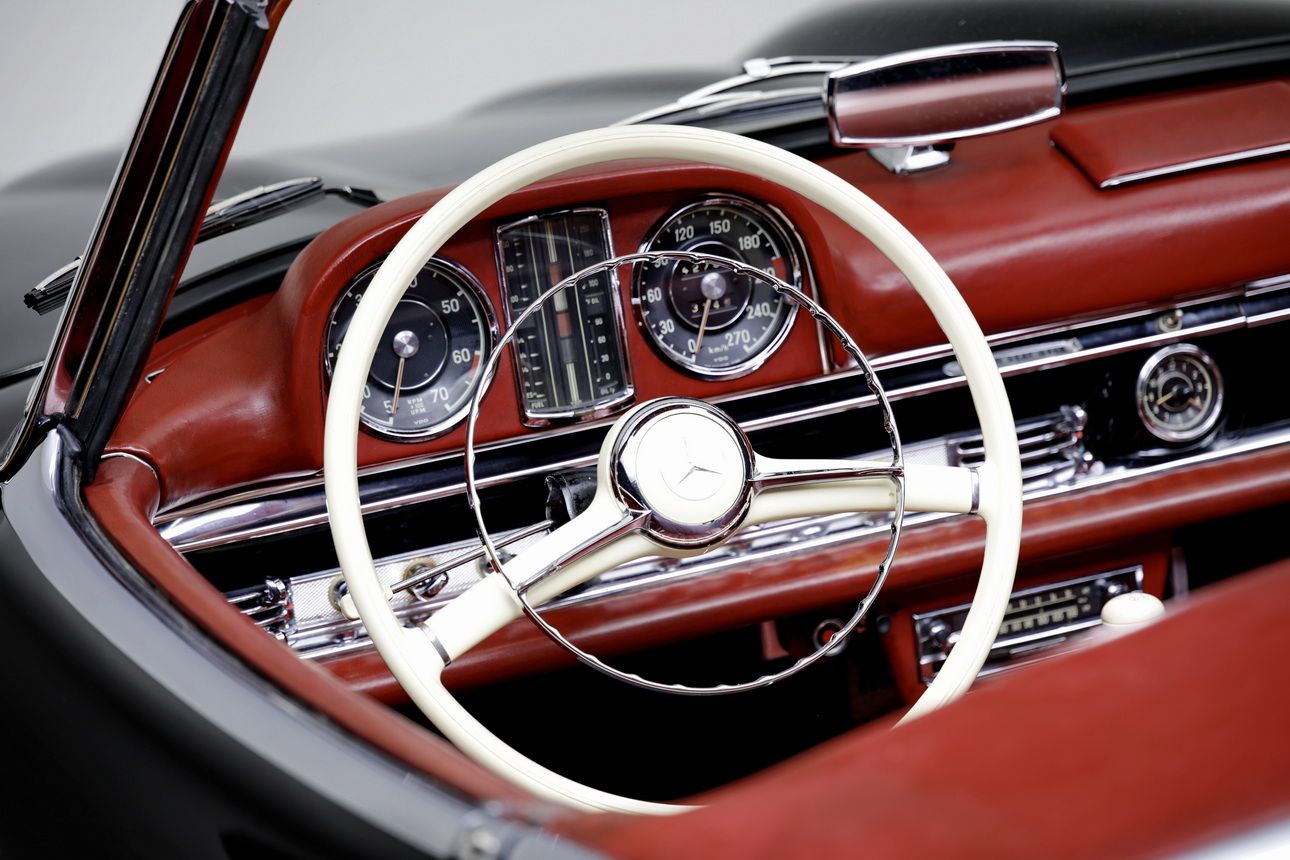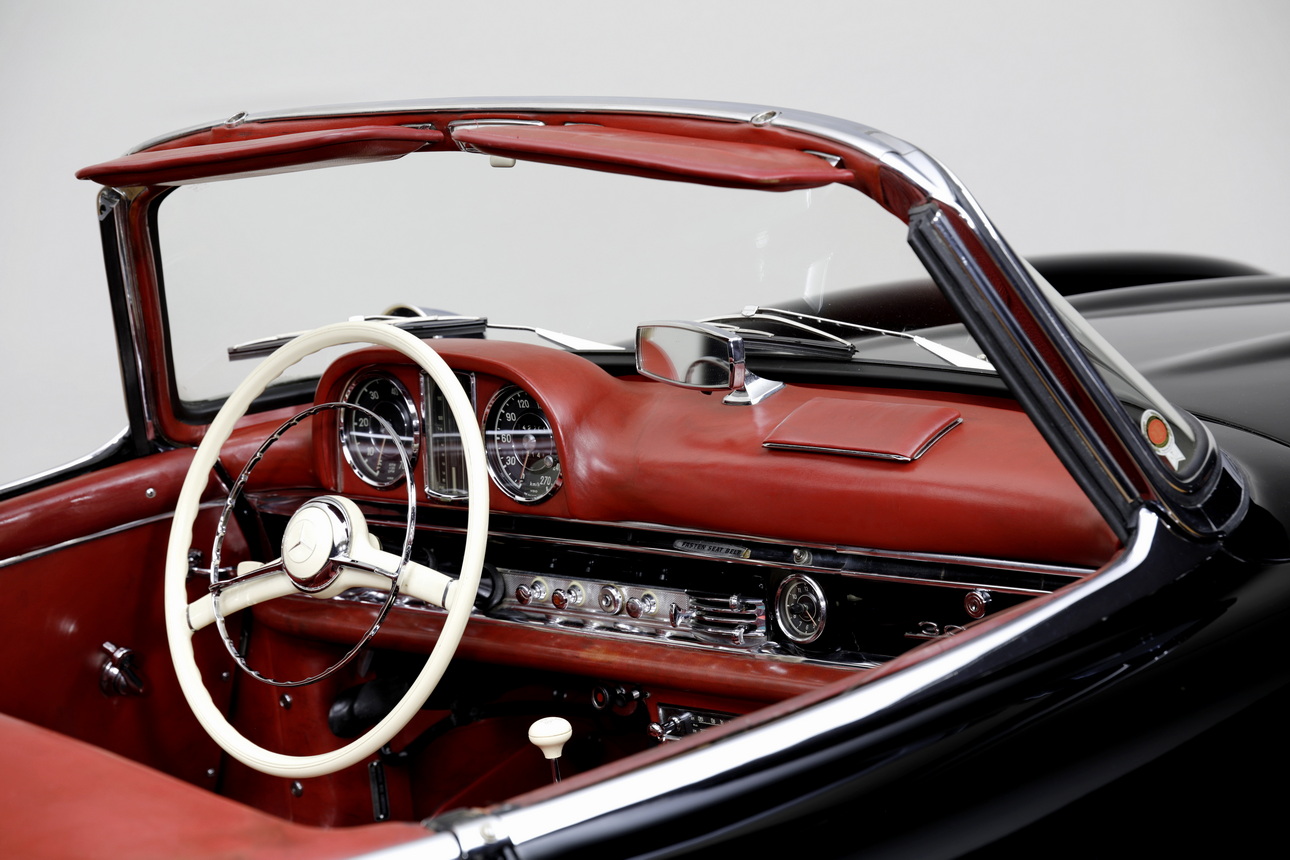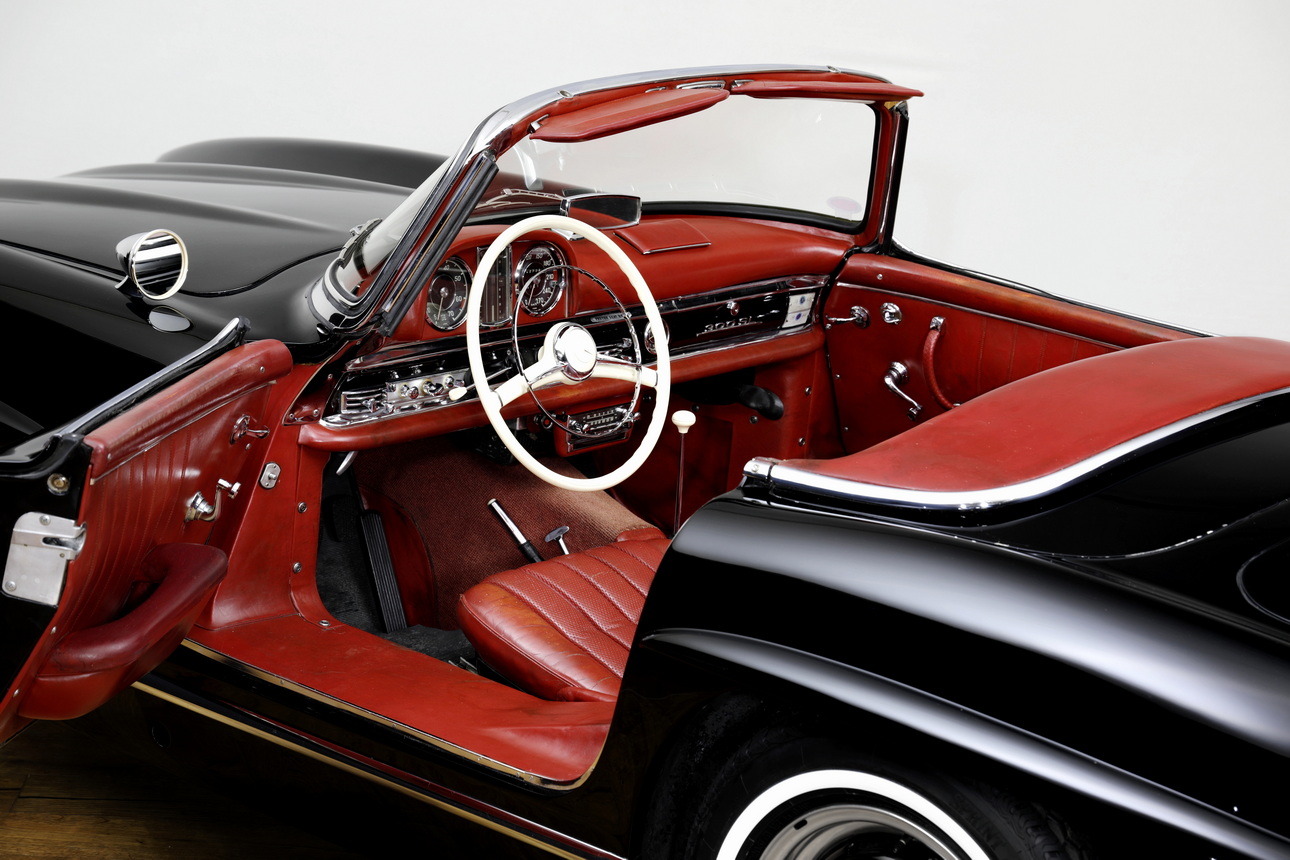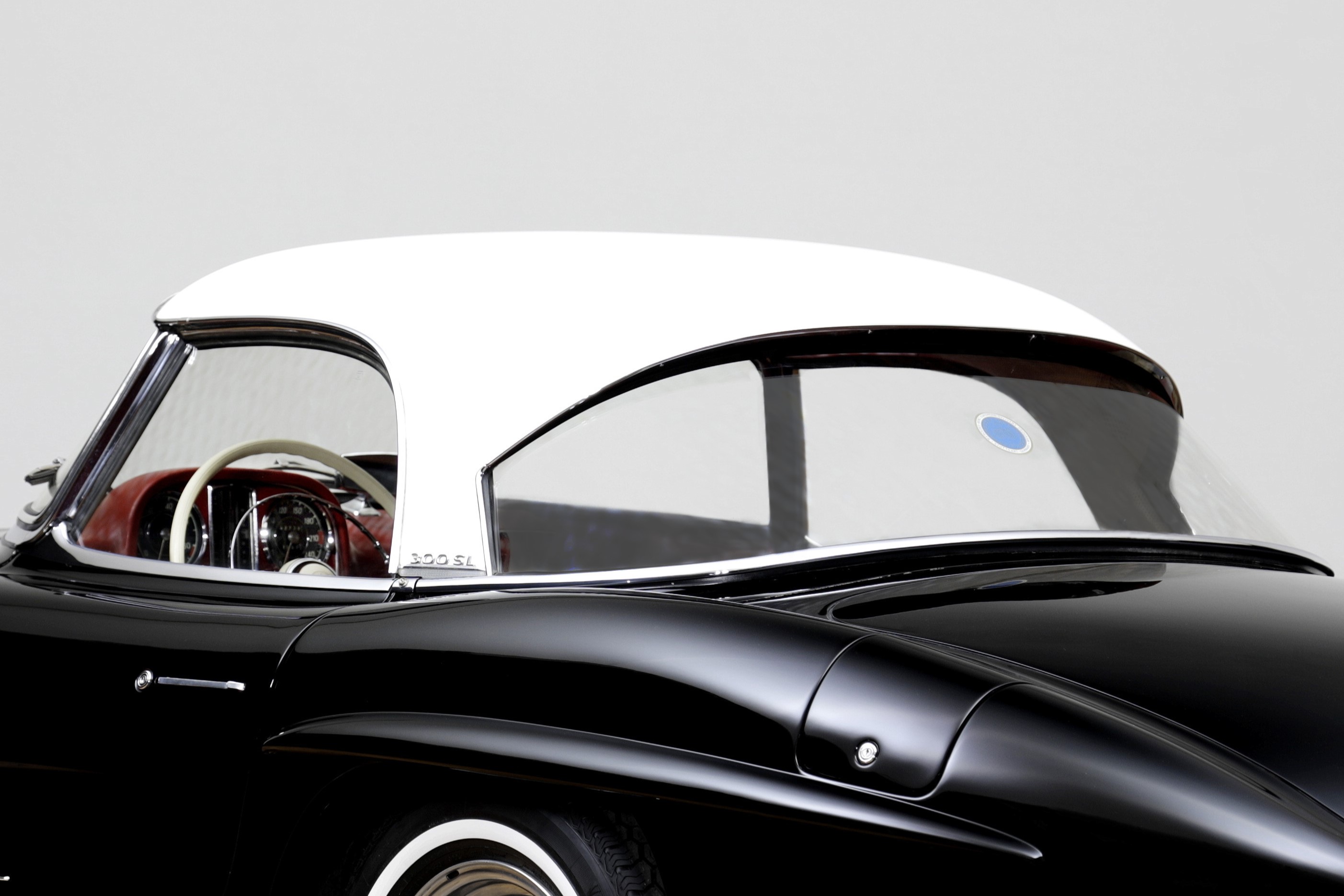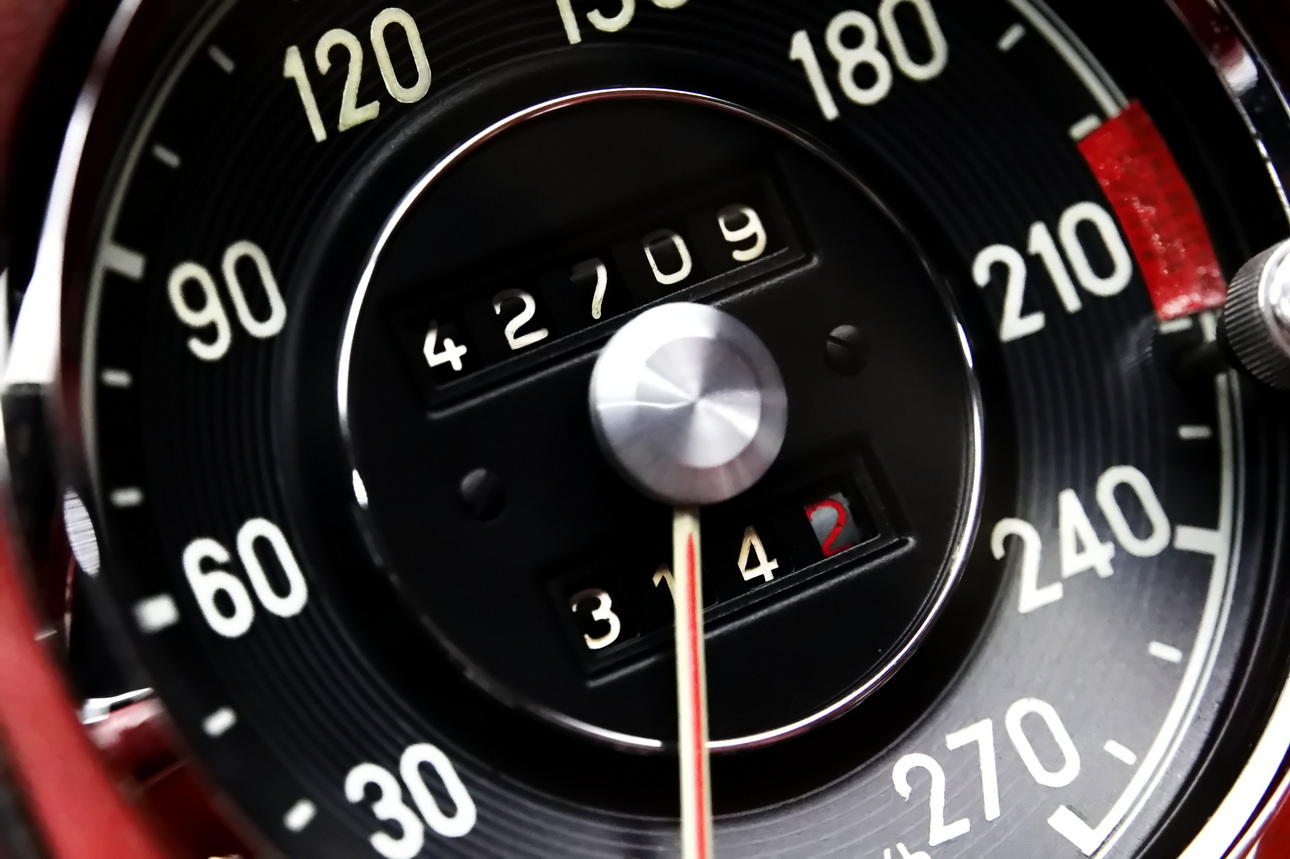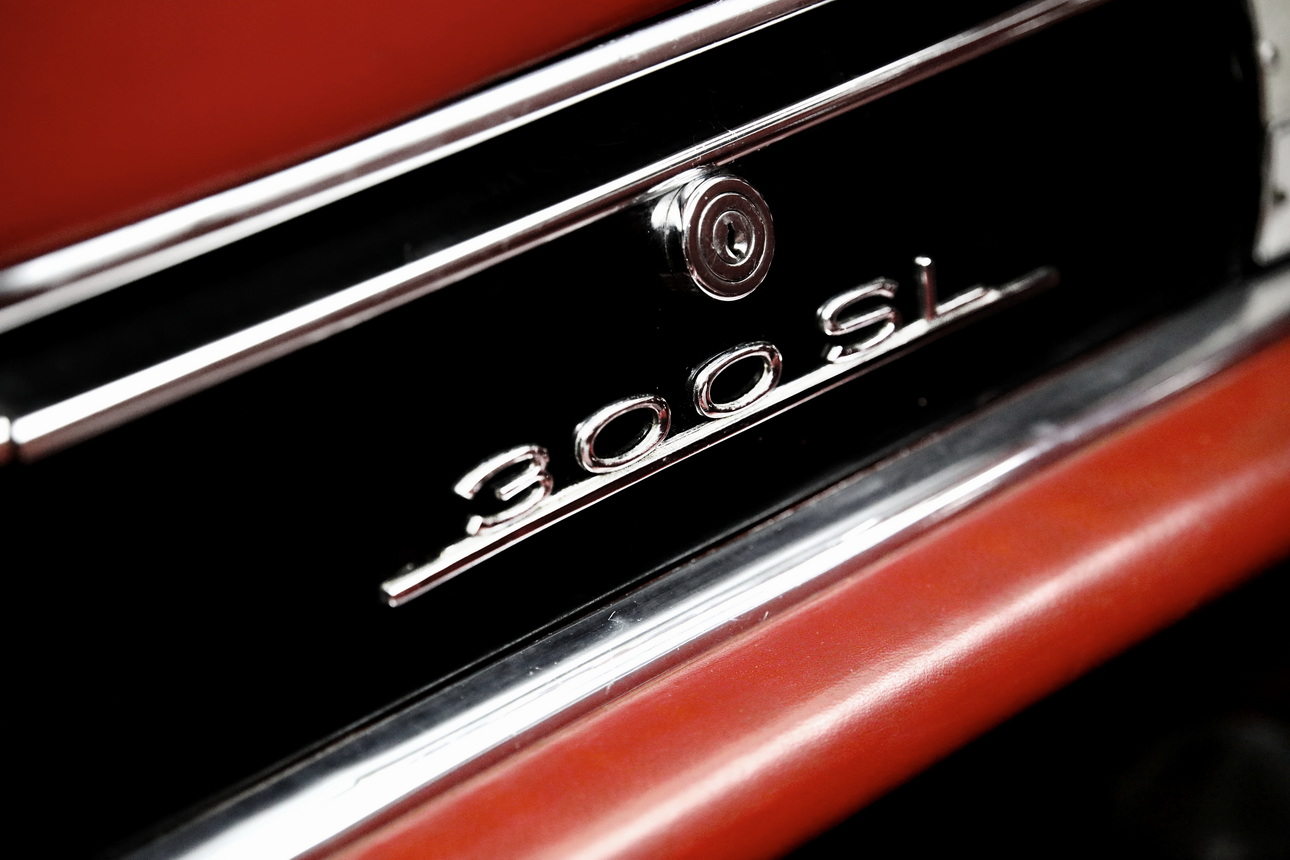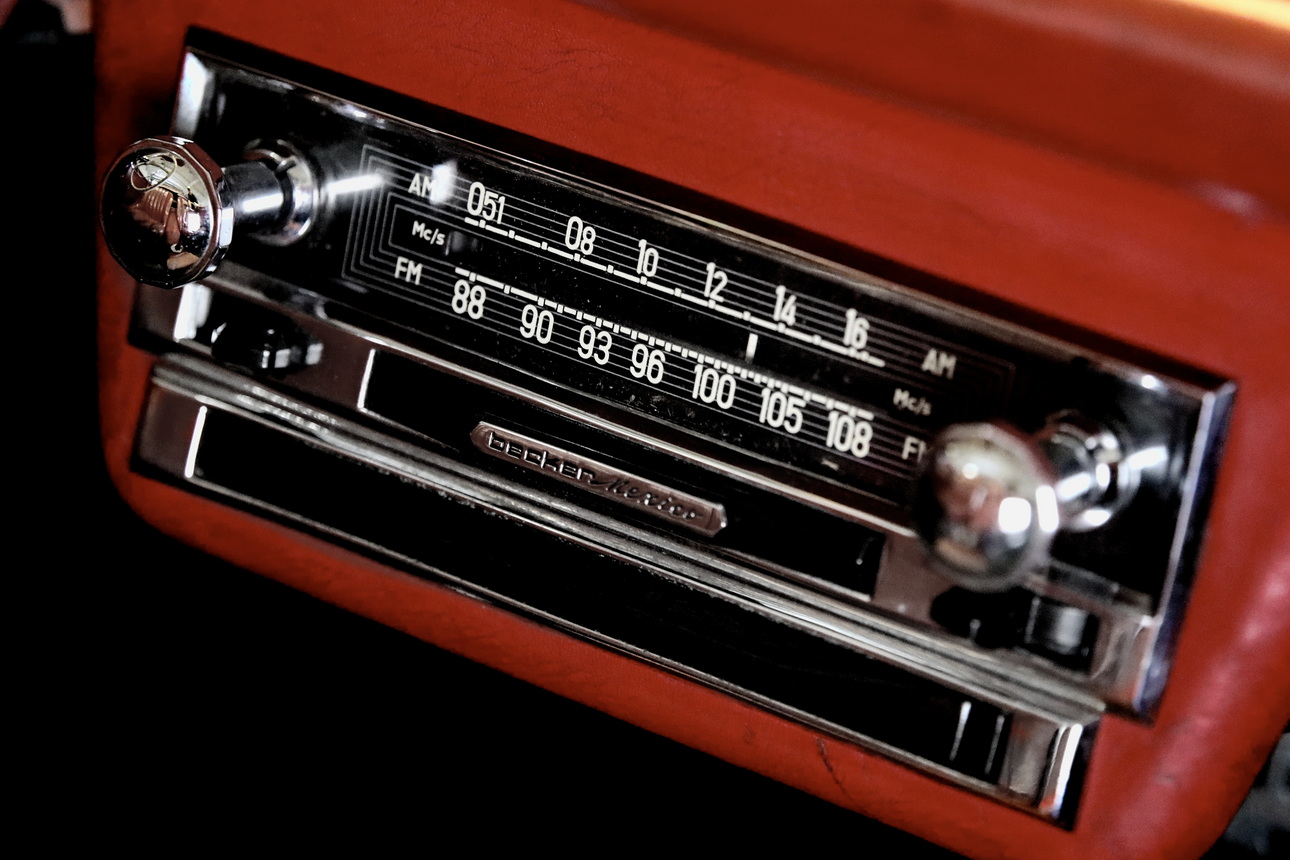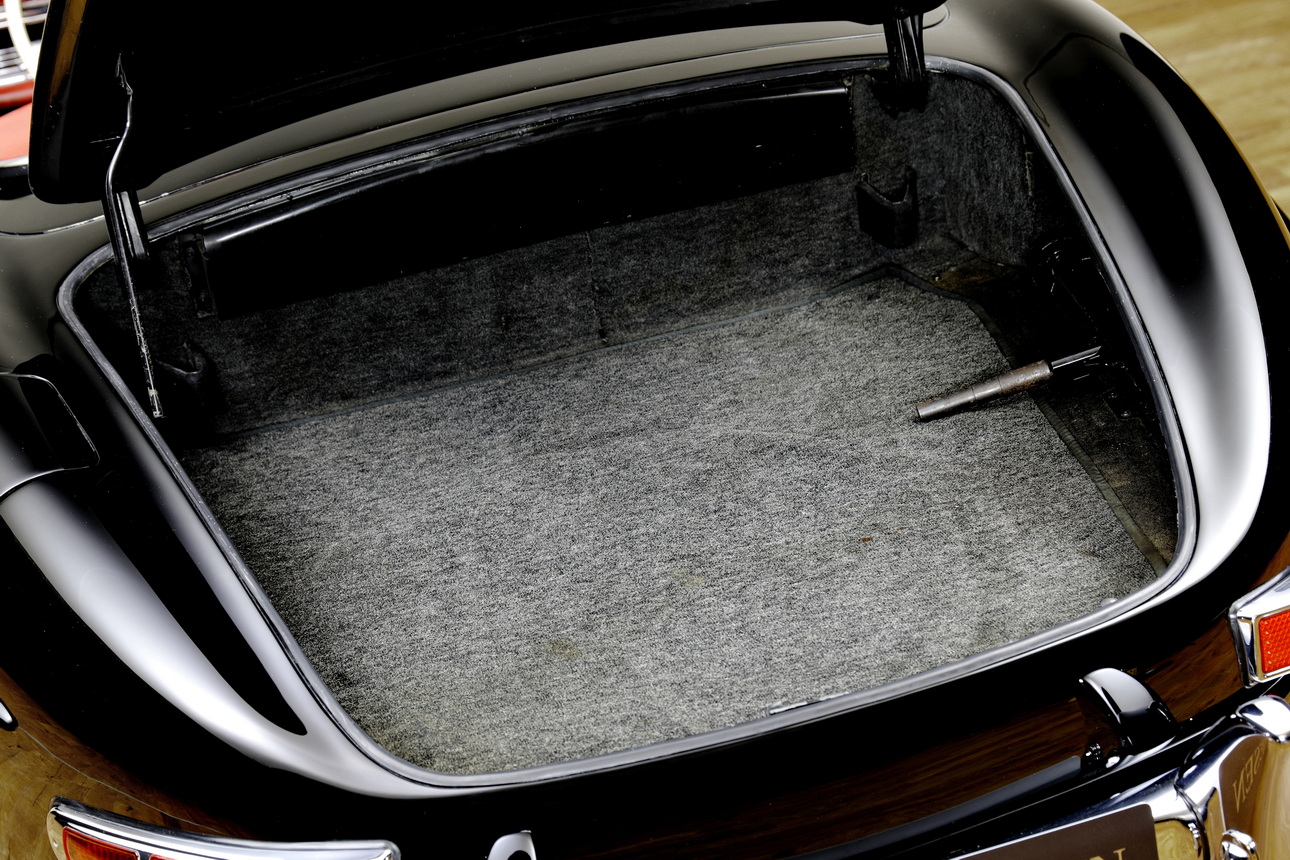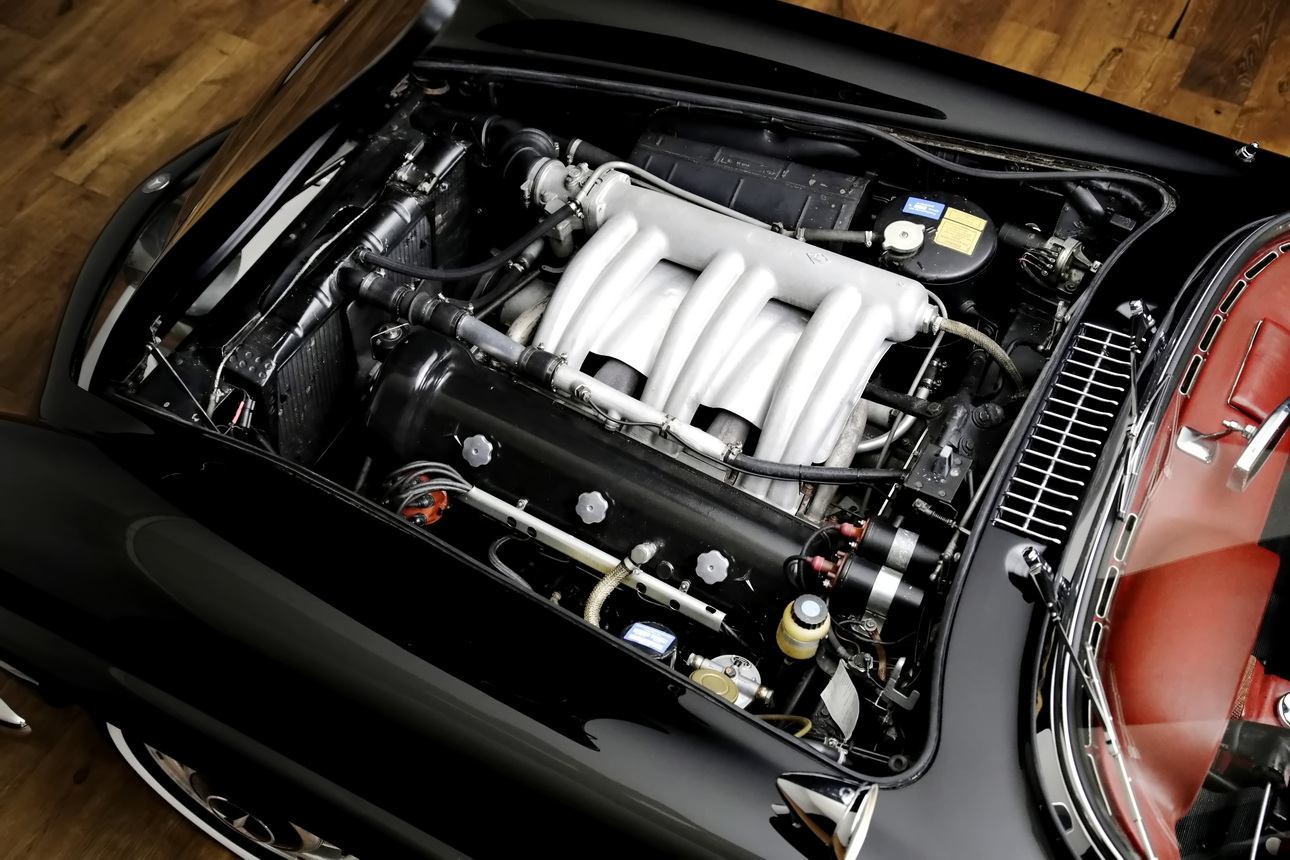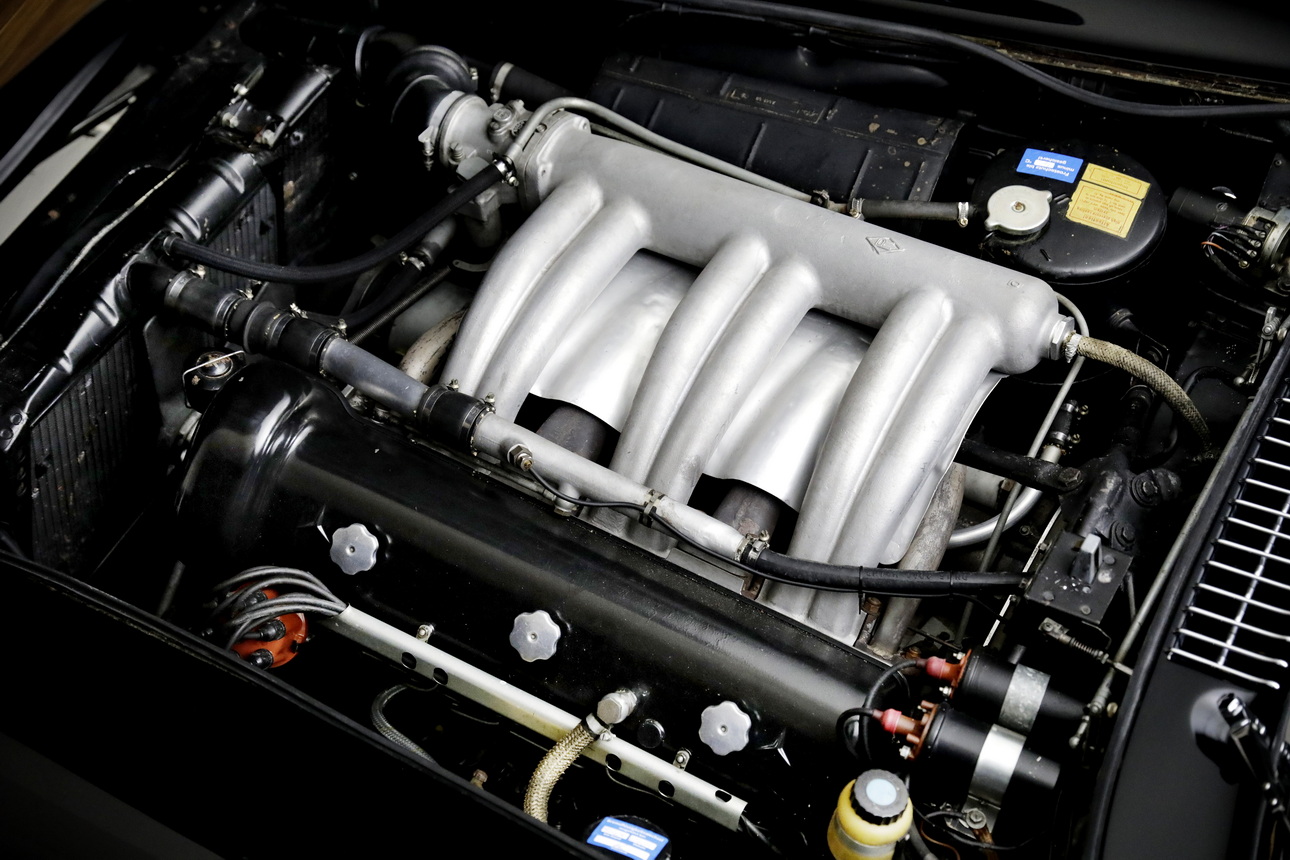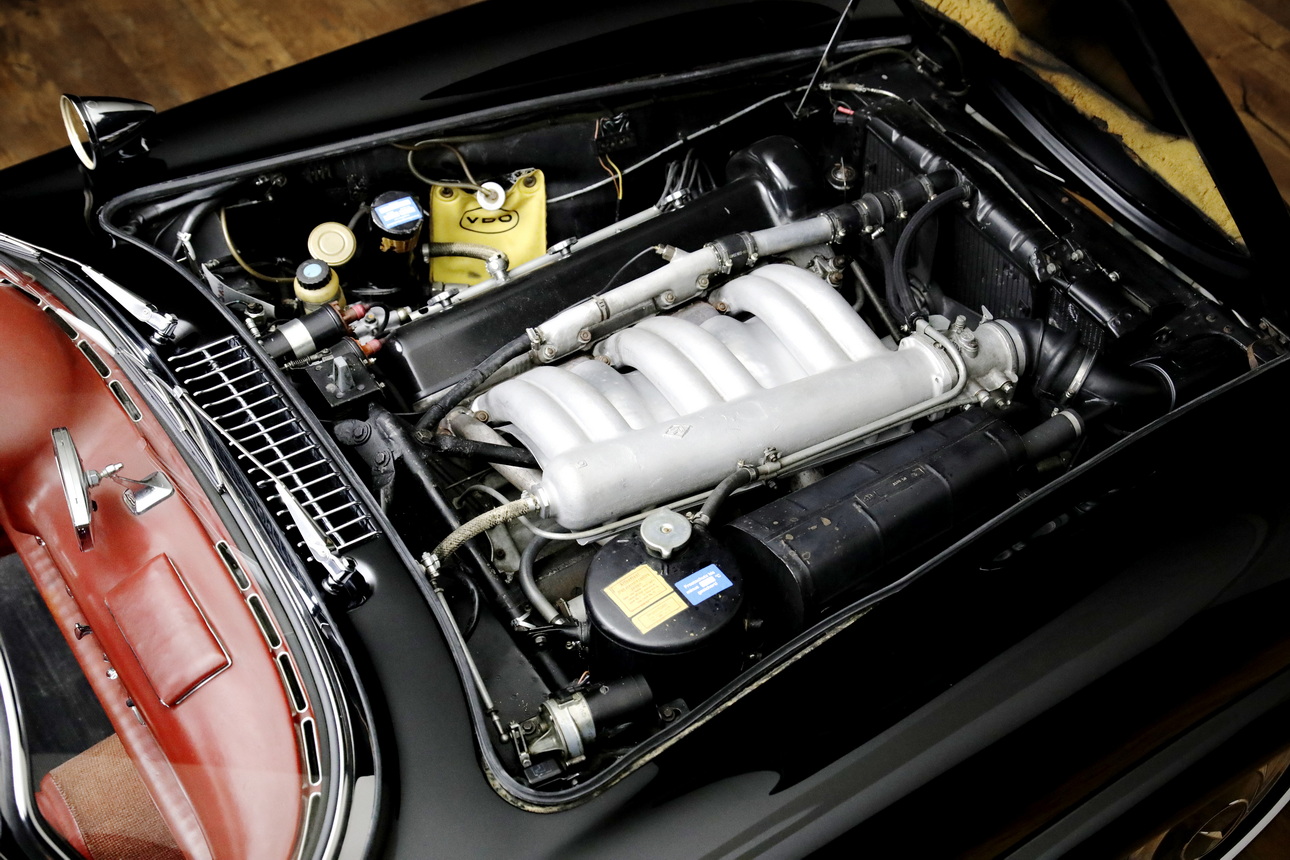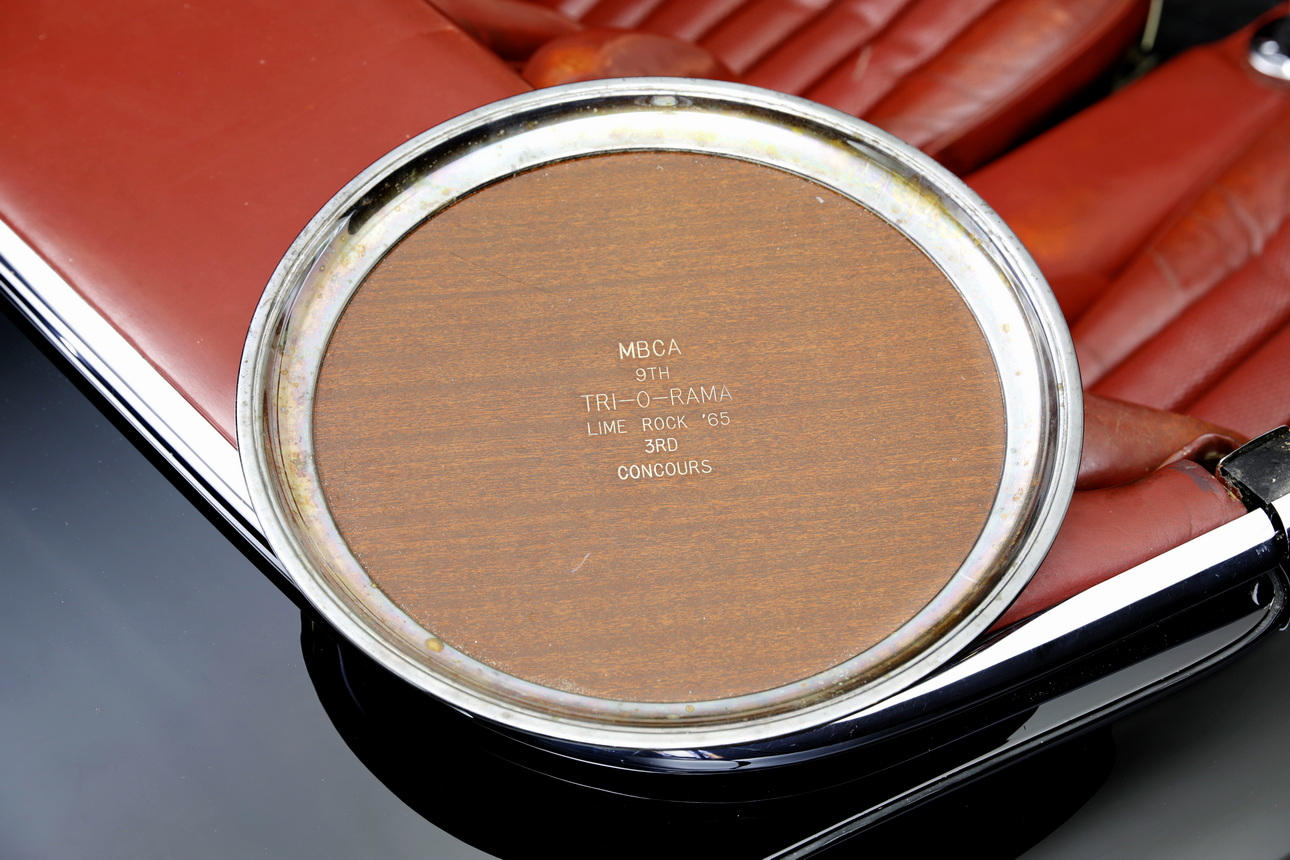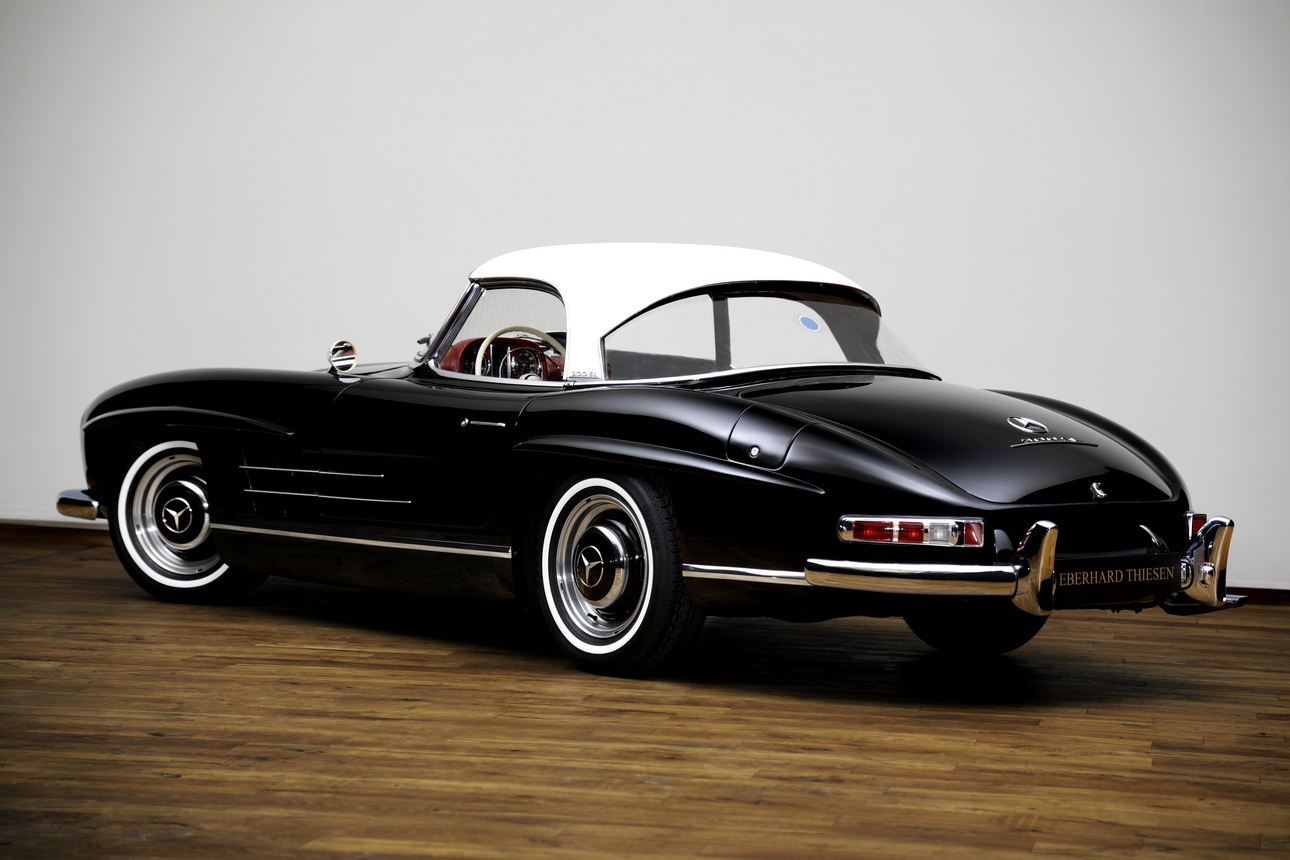Mercedes Benz 300 SL Roadster – unrestored
Highlights
Data & Facts
This Automobile
This Mercedes Benz 300 SL Roadster was completed at the factory in December 1959 and then delivered to its first owner in California via Mercedes Benz general importer Max Hoffman in New York. According to the available data card and delivery note, the original colour scheme was black (colour code 40) with a red leather interior (colour code 1079) and a black rubber fabric soft top (colour code 872). The equipment included a coupé roof (hardtop) in white (colour code 50), a Becker Mexico radio and five whitewall tyres. The roadster still has the same colour scheme today as when it was delivered.
The first owner kept the car for a full 33 years until 1993. An existing photo album shows several photographs from this period (see next page) and testifies to the first owner's deep attachment to this 300 SL, which was virtually a cherished ‘family member’. The car then ended up in a well-known automobile collection in the USA, where it remained unused for only a few years.
In 1997, the roadster came to Germany and was sold by Eberhard Thiesen to its third owner in the Viersen area (North Rhine-Westphalia). This owner also remained loyal to the 300 SL for a long time, keeping it for a full 21 years. Several invoices for various maintenance work from this period are available.
In 2018, the last owner in the Hamburg area acquired the roadster, again through Eberhard Thiesen. There it was part of a collection and in good company with a 300 SL Gullwing and other important Mercedes-Benz models.
Our 300 SL is an original example that has not yet undergone any restoration – apart from a new soft top and some technical maintenance and overhaul work. The red leather interior is still the original as fitted in the factory, with a slight patina. The engine is also the same unit as delivered and has matching numbers. With its ‘Duo Duplex’ braking system, the car features the latest technology in drum brakes of its time.
This 300 SL Roadster impresses with its extremely rare original condition and the small number of owners with a complete history. The attractive colour scheme in black with red leather provides it a sophisticated touch, and the original coupé roof in white is still included today. A great 300 SL Roadster to admire, drive and enjoy.
Model History
In 1952, the Daimler-Benz Board of Management decided to participate in international racing again and had the 300 SL racing sports car (W194) developed. Already in the same year, the car achieved remarkable successes: 2nd place at the Mille Miglia, a double victory at Le Mans with a new speed record. A quadruple record (!) at the Nürburgring followed and 1st place at the Carrera Pan Americana in Mexico.
These motorsport successes were also to be used commercially. In 1954, the road version of the 300 SL (W198) celebrated its debut in New York. The most striking features were the gullwing doors that swung upwards. The reason for this was the construction: As with the 1952 racing sports car, the road version is based on consistent lightweight structure, with a lattice tube frame carrying the engine, gearbox and axles and not allowing for conventional doors. It is also the world's first series-production passenger car with direct petrol injection.
At the Geneva Motor Show in March 1957, a roadster was presented as the successor to the Gullwing, which was technically essentially the same as the coupé. However, by modifying the side panels of the lattice tube frame, the entry height could be reduced to such an extent that ordinary doors could be realised. Thanks to a flatter rear frame and a redesigned fuel tank, the spare wheel was located under the floor. Hence, there was now space for a boot.
The rear suspension was fundamentally improved: The single-joint swing axle with a lowered pivot point, already known from the Type 220a, was now also fitted in an adapted form to the 300 SL Roadster and was equipped with a compensating spring for the first time. Compared to the Gullwing version, significantly improved driving characteristics were achieved.
Of the technical changes that went into production over the course of six years, two are particularly relevant: In March 1961, the 300 SL received Dunlop disc brakes on all four wheels, and from March 1962, a modified engine with light-alloy block was fitted. 1,858 examples of the open-top roadster were built, compared with 1,400 Gullwing versions before.
Both as a coupé and as a roadster, the 300 SL was THE car of German and international celebrities in its day – including Sophia Loreen, Romy Schneider, Juan Manuel Fangio, Clark Gable, Tony Curtis, Herbert von Karajan, Hussein von Jordan, Curt Jürgens, Gunter Sachs and many more. Production of the 300 SL came to an end in February 1963, marking the end of an era at Daimler-Benz. Both versions of the 300 SL, Roadster and Gullwing, were special enthusiasts' cars from the very beginning and have lost none of their fascination to this day.
This Automobile
This Mercedes Benz 300 SL Roadster was completed at the factory in December 1959 and then delivered to its first owner in California via Mercedes Benz general importer Max Hoffman in New York. According to the available data card and delivery note, the original colour scheme was black (colour code 40) with a red leather interior (colour code 1079) and a black rubber fabric soft top (colour code 872). The equipment included a coupé roof (hardtop) in white (colour code 50), a Becker Mexico radio and five whitewall tyres. The roadster still has the same colour scheme today as when it was delivered.
The first owner kept the car for a full 33 years until 1993. An existing photo album shows several photographs from this period (see next page) and testifies to the first owner's deep attachment to this 300 SL, which was virtually a cherished ‘family member’. The car then ended up in a well-known automobile collection in the USA, where it remained unused for only a few years.
In 1997, the roadster came to Germany and was sold by Eberhard Thiesen to its third owner in the Viersen area (North Rhine-Westphalia). This owner also remained loyal to the 300 SL for a long time, keeping it for a full 21 years. Several invoices for various maintenance work from this period are available. In 2018, the last owner in the Hamburg area acquired the roadster, again through Eberhard Thiesen. There it was part of a collection and in good company with a 300 SL Gullwing and other important Mercedes-Benz models.
Our 300 SL is an original example that has not yet undergone any restoration – apart from a new soft top and some technical maintenance and overhaul work. The red leather interior is still the original as fitted in the factory, with a slight patina. The engine is also the same unit as delivered and has matching numbers. With its ‘Duo Duplex’ braking system, the car features the latest technology in drum brakes of its time.
This 300 SL Roadster impresses with its extremely rare original condition and the small number of owners with a complete history. The attractive colour scheme in black with red leather provides it a sophisticated touch, and the original coupé roof in white is still included today. A great 300 SL Roadster to admire, drive and enjoy.
Model History
In 1952, the Daimler-Benz Board of Management decided to participate in international racing again and had the 300 SL racing sports car (W194) developed. Already in the same year, the car achieved remarkable successes: 2nd place at the Mille Miglia, a double victory at Le Mans with a new speed record. A quadruple record (!) at the Nürburgring followed and 1st place at the Carrera Pan Americana in Mexico.
These motorsport successes were also to be used commercially. In 1954, the road version of the 300 SL (W198) celebrated its debut in New York. The most striking features were the Gullwing doors that swung upwards. The reason for this was the construction: As with the 1952 racing sports car, the road version is based on consistent lightweight structure, with a lattice tube frame carrying the engine, gearbox and axles and not allowing for conventional doors. It is also the world's first series-production passenger car with direct petrol injection.
At the Geneva Motor Show in March 1957, a roadster was presented as the successor to the Gullwing, which was technically essentially the same as the coupé. However, by modifying the side panels of the lattice tube frame, the entry height could be reduced to such an extent that ordinary doors could be realised. Thanks to a flatter rear frame and a redesigned fuel tank, the spare wheel was located under the floor. Hence, there was now space for a boot.
The rear suspension was fundamentally improved: The single-joint swing axle with a lowered pivot point, already known from the Type 220a, was now also fitted in an adapted form to the 300 SL Roadster and was equipped with a compensating spring for the first time. Compared to the Gullwing version, significantly improved driving characteristics were achieved.
Of the technical changes that went into production over the course of six years, two are particularly relevant: In March 1961, the 300 SL received Dunlop disc brakes on all four wheels, and from March 1962, a modified engine with light-alloy block was fitted. 1,858 examples of the open-top roadster were built, compared with 1,400 Gullwing versions before.
Both as a coupé and as a roadster, the 300 SL was THE car of German and international celebrities in its day – including Sophia Loreen, Romy Schneider, Juan Manuel Fangio, Clark Gable, Tony Curtis, Herbert von Karajan, Hussein von Jordan, Curt Jürgens, Gunter Sachs and many more. Production of the 300 SL came to an end in February 1963, marking the end of an era at Daimler-Benz. Both versions of the 300 SL, Roadster and Gullwing, were special enthusiasts' cars from the very beginning and have lost none of their fascination to this day.

